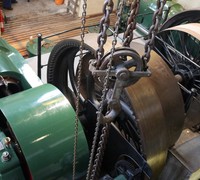GAS ENGINE ROOM (CMT Trail stop 3)

For the trail of the Cambridge Museum of Technology, we've divided the spaces into eleven stops. Each stop is offered as a transcription (see below) illustrated for those who are not able-bodied to see the details of the site through descriptions and photography. You can use the audio guide online or in situ which is provided freely here, stop by stop, starting with GAS ENGINE ROOM (CMT Trail stop 3) AUDIO.
CMT TRAIL STOP 3 WORDS SPOKEN BY CAMBRIDGE MUSEUM OF TECHNOLOGY'S CURATOR, PAM HALLS: And here we are in the Gas Engine Room. This was added about 14 years after the room we were just in with the steam engines. The reason was that Cambridge continued to grow, there were more houses, more roads and there was nowhere for the water, the rainwater coming down, to naturally soak away. Just as today that we are worried about people concreting over their front gardens, there is nowhere for the water to go except into the sewers and also Cambridge's sewage system was what's called a combined sewage system so they didn't just take sewage from peoples toilets it also took all the rainwater that came down onto roofs and it all drained into the sewers which most of the time was perfectly fine but if you had a lot of rain then you had to be able to deal with it quite quickly. If we had a downpour then within about half an hour of that, sewage in the well mixed with the rainwater could be rising very, very high and those steam engines could not cope so they introduce these two green lovely National Gas engines and you could turn them on very very quickly. They could get going within about five or 10 minutes and they were fed by gas from the gasworks which was once next door to the pumping station. They didn't pump directly to Milton most of the time they used the pump into some large holding tanks which you can sometimes see on maps and aerial photos of the town from the 1910s onwards. They are like huge swimming pools and what they would do is they would pump the storm water surge into those tanks, wait for the storm to pass over and then the steam engines would take over and pump down the main out to Milton. If you listen now you can hear water and gravity continues to bring a lot of the surface water from the roads this site.
ILLUSTRATION
EN-ROUTE TO ELECTRIC ROOM (stop 4)
Right, we’ll go up the step now and through to the Electric Room. Now on the floor here you can see long strips, they are actually the drive belts that had once been used on the Gas Engines so another bit of recycling at the pumping station, Victorians were very keen on their recycling. And down some steps.
TRAIL STOP PHOTOS & SELFIES: Please do use social media to submit an arty photo or a selfie taken at this stop. Have a go to take an arty photo of an object. Or fit in your entire family with the chimney! Historyworks will upload photos to the trail stop to share with others! All you have to do is share on twitter using @historyworkstv and @CamTechMuseum or email your photos to the team at historyworkstv@gmail.com HAPPY SNAPPING :-)
HAVE A LOOK AT PHOTOS AT THE CAMBRIDGE MUSEUM OF CAMBRIDGE MOSTLY TAKEN BY THE HISTORYWORKS TEAM SHOWING DETAILS OF MACHINES TO ILLUSTRATE THE TRAIL STOPS, BUT PLEASE SEE THAT THESE NOW INLUDE SELFIES AND ARTY PHOTOS FROM THE STOBBS IP PARTICIPANTS, ADDED TO PHOTOS TAKEN BY HELEN WEINSTEIN & MARIO SATCHWELL & JON CALVER OF HISTORYWORKS:
Created with flickr slideshow.













